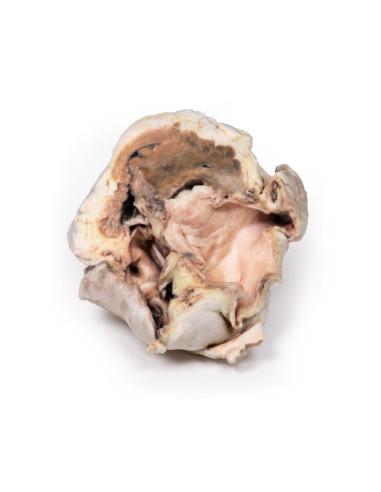Calcified aortic valve stenosis Bicuspid aortic valve - Erler Zimmer 3D anatomy Series MP2038
erler zimmerMade in ultra-high resolution 3D printing in full color.
Calcified aortic valve stenosis Bicuspid aortic valve - Erler Zimmer 3D anatomy Series MP2038
This dissection model is part of the exclusive Monash 3D anatomy series, a comprehensive series of human dissections reproduced with ultra-high resolution color 3D printing.
Clinical History.
There is no clinical history for this specimen.
Pathology
The specimen is a 1.5-cm partial horizontal slice through the plane of the left atrium whose smooth inner lining along with the left auricular appendage and part of the left ventricle are visible on the inferior aspect. On the upper aspect the pulmonary trunk (and part of the pulmonary tricuspid valve) and aorta, including the affected abnormal bicuspid valve, are clearly distinguishable. Calcified aggregations or thickening on the opposite margins of the valve can be seen from this superior perspective. There is also a region of calcification on one of the cusps of the pulmonary valves.
Further information
Bicuspid aortic valve is a common congenital anomaly that often goes undetected in adulthood. In fact, it is the most common congenital anomaly of the heart. Aortic valve stenosis can range from mild to severe, and signs and symptoms generally develop when the narrowing of the valve is severe. Some people with aortic valve stenosis may not experience symptoms for many years. Signs and symptoms may include abnormal heart noise (heart murmur), radiating chest pain (angina), shortness of breath and chest pain, especially during periods of increased activity, heart palpitations-sensations of a rapid, fluttering heartbeat. The heart-weakening effects of aortic valve stenosis can lead to heart failure. Signs and symptoms of heart failure include fatigue, shortness of breath and swollen ankles and feet.
When the aortic valve narrows, the left ventricle has to work harder to pump enough blood into the aorta and then into the rest of the body. This can cause the left ventricle to thicken and widen. Eventually the extra work of the heart can weaken the left ventricle and the heart in general, with it eventually being unable to function properly (heart failure), causing other problems downstream.
Calcium deposits accumulate on the valve, particularly those with a congenitally abnormal aortic valve, such as a bicuspid aortic valve, resulting in stiffening of the valve cusps. This stiffening narrows the lumen of the aortic valve and thus increases blood flow.
.
What advantages does the Monash University anatomical dissection collection offer over plastic models or plastinated human specimens?
- Each body replica has been carefully created from selected patient X-ray data or human cadaver specimens selected by a highly trained team of anatomists at the Monash University Center for Human Anatomy Education to illustrate a range of clinically important areas of anatomy with a quality and fidelity that cannot be achieved with conventional anatomical models-this is real anatomy, not stylized anatomy.
- Each body replica has been rigorously checked by a team of highly trained anatomists at the Center for Human Anatomy Education, Monash University, to ensure the anatomical accuracy of the final product.
- The body replicas are not real human tissue and therefore not subject to any barriers of transportation, import, or use in educational facilities that do not hold an anatomy license. The Monash 3D Anatomy dissection series avoids these and other ethical issues that are raised when dealing with plastinated human remains.








